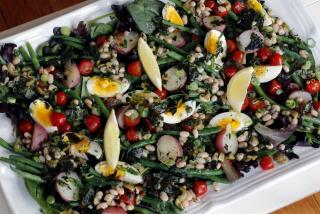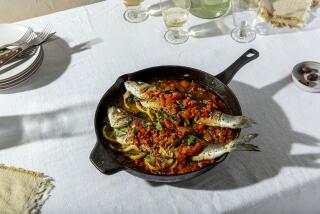Of Rustic Origins : The High-Fiber, Low-in-Saturated-Fats Mediterranean Diet Goes Up-Country
- Share via
AMERICANS have recently discovered the so-called Mediterranean diet, an eating style common to inhabitants of the Mediterranean basin that is high in fiber, low in saturated fats and full of grains, fruit, vegetables and seafood. This diet is old news in Europe. French food writer Austin de Croze was aware of it as early as 1931. That year, in a book entitled “What to Eat and Drink in France,” he wrote: “We know of the nutritive power of figs and walnuts to the Greeks, of macaroni and polenta to the Italians, rice and pimentos to the Spaniards, black olives and tomatoes to the Provencals, green pimentos and garlic to the Languedocians, anchovies and garlic to the Roussillonnais--all the foods made golden by olive oil.”
What de Croze didn’t go on to say, however, is that one of the groups he mentions, the Roussillonnais, temper their Mediterranean diet with the hearty gastronomic imperatives of mountain living. The Roussillon occupies a corner of France defined on one side by the Mediterranean and on another by the rugged Pyrennes themselves.
The food of this region has an appealingly rustic honesty. Fruit and vegetables are important ingredients in the cuisine, as they are in most of the Mediterranean--the apples, pears and cherries of the Pyrenean foothills are particularly famous. Seafood is popular, especially shellfish and (as de Croze noted) anchovies, but there is also quite a bit of wild game consumed, and both veal and lamb are common.
Typical dishes of the Roussillon include spiny lobster civet (a rich, wine-moistened stew), a garlicky near-bouillabaisse called la bouillinade , sauteed partridge or pigeon with garlic and lemon slices, and a thick rice-and-cabbage soup flavored with blood sausage and other charcuterie .
One other specialty of the region, somewhat less fearsome than the aforementioned, is veal stewed with green olives. Like so many related dishes on both sides of the eastern Pyrenees, this stew is based on a sofregit , or “underfry,” of onions and garlic, simmered for hours in olive oil until reduced to a sweet near-puree. ( Sweet is the right word: Food scientist Harold McGee has pointed out that there are compounds in onions that “appear to be converted into another complex molecule that is 50 to 70 times sweeter than a molecule of table sugar.”) To quote another gastronome of earlier times, a British writer who signed himself Lieut.-Col. Newnham-Davis: “The seductions of the burnt onion and the garlic clove are the foundations upon which rest the whole edifice of Pyrenean cooking.”
While this is admittedly a hearty dish, full of concentrated flavors, it isn’t laden with fat or dangerously spicy or crowded with strange varieties of sausage. It’s just a delicious example of what the Mediterranean diet can encompass when it goes up-country. It can be served alone, over rice, or Pyrenean-style with an accompaniment of simply cooked white beans.
Veal Stewed With Green Olives 5 to 6 tablespoons olive oil 3 large onions, coarsely chopped 4 to 6 cloves garlic, peeled and minced 4 large, ripe tomatoes, peeled, seeded and finely chopped 3 1/2 pounds veal stew meat or boneless veal breast or veal shank, cut into irregular pieces about 1x2x3 inches 2 cups veal or beef stock 3 to 4 sprigs fresh marjoram leaves (or 1/2 teaspoon dried marjoram) 4 to 5 sprigs parsley, minced 1 bay leaf Salt and pepper 2 cups good-quality green olives (see note), rinsed and pitted
Heat 3 tablespoons olive oil in large skillet. Add onions and garlic and simmer uncovered over lowest heat, stirring occasionally, 3 to 4 hours. Onion mixture should be medium-brown in color and have consistency of coarse marmalade.
Add tomatoes to onion mixture, stir well, and continue cooking over low heat.
Heat 2 to 3 tablespoons olive oil in large stew pot or Dutch oven, and brown in it meat on all sides over medium-high heat, turning meat with tongs often and removing to a plate when browned.
Deglaze stew pot with stock, scraping burnt bits off bottom with wooden spoon; then reduce heat to low and add onion-and-tomato mixture. Stir well into stock; then return meat to pot. Add marjoram, bay leaf and half parsley to liquid. Season to taste with salt and pepper. Cover pot and simmer 3 hours, stirring occasionally.
About 30 minutes before stew is done, stir in olives, re-cover pot, and continue cooking. To serve, garnish with remaining parsley. Serves 8.
Note: Good choices include picholine du Gard olives, imported from France under several labels, or Santa Barbara Brand Country-Style Olives. Avoid olives strongly flavored with garlic or herbs. Pre-pitted olives seem to lose flavor and texture in the pitting process. Food stylist: Amy Nathan
More to Read
Eat your way across L.A.
Get our weekly Tasting Notes newsletter for reviews, news and more.
You may occasionally receive promotional content from the Los Angeles Times.










